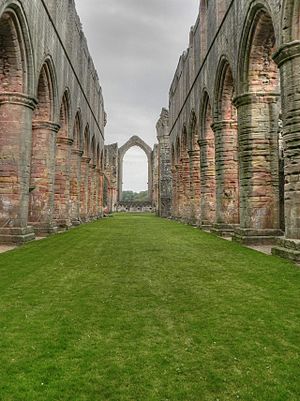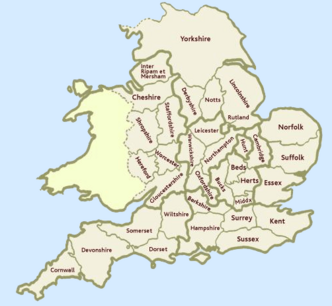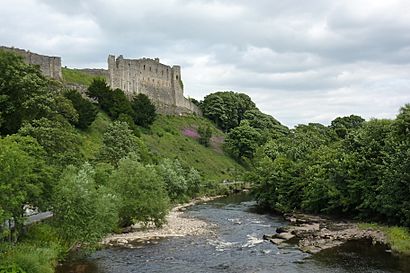Harrying of the North facts for kids
The Harrying of the North was a series of harsh military actions led by William the Conqueror during the winter of 1069–1070. William had recently conquered England, and these actions were meant to crush rebellions in Northern England. People in the North, including Anglo-Saxons, Anglo-Scandinavians, and Danes, were rebelling because Edgar Ætheling, a claimant to the English throne, was there.
William paid the Danes to leave. However, the remaining rebels refused to fight him directly. So, William decided to starve them out. He used a "scorched earth" tactic, which means destroying everything in an area. His army laid waste to the Northern shires, especially Yorkshire and the city of York. After this, William removed English leaders and put his own Norman lords in charge across the region.
Old records from that time describe how brutal the campaign was. They talk about huge destruction, widespread famine (when many people starve), and lots of killing and burning. Some historians today call these campaigns a genocide because of how many people died. However, others wonder if William had enough soldiers to cause so much damage, suggesting the old records might have been exaggerated. Records from the Domesday Book (a survey done in 1086) suggest that up to 75% of the population might have died or never returned to their homes.
Contents
Why the Harrying Happened
The North Before William's Attack
At the time of the Norman Conquest, "the North" mainly included what we now call Yorkshire, Durham, and Northumberland in the east. In the west, it included Lancashire and parts of Cumberland and Westmorland. The people living in the North before William's conquest were a mix of Viking and Anglo-Saxon traditions, often called "Anglo-Scandinavian". The English language spoken in Yorkshire was likely different from the English spoken in the South. Many of the noble families there were originally Danish.
It was also hard to travel between the North and South of England. This was partly because of the land itself and partly because the roads were very bad. Many people preferred to travel by ship between York and the South. Years before, in 962, King Edgar the Peaceful had given the Northern earls of the Danelaw special legal freedom in exchange for their loyalty. This meant that the Anglo-Saxon kings who came after him had less power north of the Humber river. The earldom of Northumbria stretched from the Tees to the Tweed.
Rebellions Against William
After Harold Godwinson was defeated and died at the Battle of Hastings, many English people continued to resist William's rule. Their main hope was Edgar Ætheling, who was a grandson of a former English king. It's said that the English finally gave up fighting William not at Hastings, but two months later at Berkhamsted in December 1066. There, Edgar and his supporters surrendered to William. However, only Archbishop Ealdred of York remained loyal to William.
William faced many rebellions and small battles across England, including in Dover, Exeter, Hereford, Nottingham, Durham, York, and Peterborough.
One important figure was Copsi, a Northumbrian noble whose family had ruled the area before. Copsi had fought against Harold Godwinson in 1066. When he swore loyalty to William in 1067, William made him the Earl of Northumbria. But just five weeks later, Copsi was killed by Osulf. When Osulf was also killed, his cousin, Cospatrick, bought the earldom from William. However, Cospatrick soon joined Edgar Ætheling in a rebellion against William in 1068.
With two earls killed and one changing sides, William decided to go to Northumbria himself. He arrived in York in the summer of 1068. The rebels, including Edgar, fled and found safety with King Malcolm III in Scotland.
Back in Northumbria, William changed his plan. Instead of appointing an Anglo-Saxon, he made a Norman, Robert de Comines, the new earl. Despite warnings that a rebel army was ready, Robert rode into Durham on January 28, 1069. He and his men were surrounded and killed. The rebels then attacked York, killing the castle's guardian and many of his men. William reacted quickly and harshly. He returned to York, attacked the rebels, and either killed them or made them flee.
Encouraged by the fighting in the North, rebellions also broke out in other parts of England. William sent his earls to deal with problems in Dorset, Shrewsbury, and Devon, while he handled rebels in the Midlands and Stafford.
Edgar Ætheling asked for help from King Sweyn II of Denmark, who was a nephew of King Canute. Sweyn gathered a fleet of ships led by his sons. This fleet sailed along the east coast of England, raiding as they went. The Danes and their English allies recaptured York.
In the winter of 1069, William marched his army from Nottingham to York to fight the rebels. But by the time William's army reached York, the rebels had fled, and Edgar had returned to Scotland. Since the Danes had no good place to stay on land for the winter, they went back to their ships in the Humber Estuary. William negotiated with them, agreeing to pay them if they would return home to Denmark without a fight.
With the Danes gone, William turned his attention to the remaining rebels. Since they wouldn't face his army in a direct battle, he decided to cut off their support and food supply.
William's Harsh Campaign
The Destruction of the North
William's plan, carried out during the winter of 1069–70 (he spent Christmas 1069 in York), was extremely brutal. Some modern historians have called it an act of genocide. Even William's own biographers at the time saw it as his cruelest act and a "stain upon his soul."
Orderic Vitalis, a chronicler writing about 50 years later, described the Harrying of the North:
The King stopped at nothing to hunt his enemies. He cut down many people and destroyed homes and land. Nowhere else had he shown such cruelty. To his shame, William made no effort to control his fury, punishing the innocent with the guilty. He ordered that crops and herds, tools and food be burned to ashes. More than 100,000 people died of starvation. I have often praised William in this book, but I can say nothing good about this brutal slaughter. God will punish him.
The land on both sides of William's route north from the River Aire was completely destroyed. His army burned crops and settlements, forcing rebels to hide. In early 1070, he divided his army into smaller groups and sent them out to burn, loot, and terrorize. From the Humber to the Tees, William's men burned entire villages and killed the people living there. Food and animals were destroyed so that anyone who survived the initial attacks would starve during the winter.
Florence of Worcester, writing in the 12th century, said that:
[King William] gathered an army and quickly went into Northumbria, giving in to his anger; and he spent the whole winter destroying the country, killing the people, and causing all sorts of harm without stopping.
People who survived the Harrying fled to places as far away as Worcestershire and lowland Scotland.
Evidence of Destruction
In 1086, the Domesday Book recorded that large parts of Yorkshire were still "waste" or "wasted." This meant that 60% of all land holdings were ruined. It also stated that 66% of all villages had ruined manors. Even the richer areas of the county had lost 60% of their value compared to 1066. Only about 25% of the population and farm animals remained, with a reported loss of 80,000 oxen and 150,000 people. The Domesday Book showed a huge drop in land values in Yorkshire between 1066 and 1086.
| Tenant-in-chief | Value of estates in 1066 (£) |
Value of estates in 1086 (£) |
|
|---|---|---|---|
| Hugh earl of Chester | 260.0 | 10.5 | |
| Robert count of Mortain | 239.3 | 33.4 | |
| Count Alan of Brittany | 211.7 | 80.2 | |
| Robert and Berengar of Tosny | 21.3 | 21.0 | |
| Ilbert of Lacy | 313.3 | 159.9 | |
| Roger of Bully | 134.1 | 76.5 | |
| Robert Malet | 29.6 | 9.3 | |
| William of Warrenne | 18.0 | 40.0 | |
| William of Percy | 91.9 | 54.8 | |
| Drogo de la Beuvriè | 553.8 | 93.3 | |
| Ralph of Mortemer | 22.5 | 10.0 | |
| Ralh Paynel | 22.0 | 5.1 | |
| Geoffrey de la Guerche | 4.0 | 1.5 | |
| Geoffrey Alselin | 16.0 | 4.5 | |
| Walter of Aincourt | 6.0 | 2.0 | |
| Gilbert of Gant | 12.0 | 3.0 | |
| Gilbert Tison | 47.4 | 26.6 | |
| Richard FitzArnfastr | 5.5 | 3.2 | |
| Hugh FitzBaldric | 96.5 | 7.4 | |
| Erneis of Burun | 23.7 | 10.8 | |
| Osbern of Arches | 53.5 | 23.2 | |
| Odo the Crossbowman | 4.5 | 4.8 | |
| Aubrey of Coucy | 5.5 | 3.0 | |
| Gospatrick | 19.6 | 9.7 | |
| Roger the Poitevin | ? | ? | |
Sources:
|
|||
Archaeological findings also support the idea of massive destruction and people being forced to leave their homes. For example, archaeologists have found hidden collections of coins in Yorkshire, which people buried during the violence of 1069–71.
Some historians, however, question whether William's relatively small army could have caused such widespread damage. They suggest that raiding Danes or Scots might have also contributed to the destruction. Others argue that "waste" in the Domesday Book might not always mean total destruction. It could mean the land was being reorganized, or that the Domesday surveyors simply didn't have enough information about the area.
Mark Hagger suggests that William's Harrying of the North was "stern beyond measure," but he argues it shouldn't be called a genocide by today's standards. He points out that William was acting by the rules of his own time. Ancient military writers like Vegetius taught that the main goal in war was to secure food for your own army and destroy the enemy by starvation. So, Hagger concludes that the Harrying of the North was not worse than other similar conflicts of that period.
Other historians also question the number of deaths given by Orderic Vitalis. He was born in 1075 and wrote his history about 55 years after the event. The figure of 100,000 deaths might have been used to show how terrible it was, rather than being an exact count. At that time, the total population of England was estimated to be around 2.25 million, so 100,000 would have been a very large number.
David Horspool suggests that while the Harrying of the North was seen as a "shock" in Northern England for centuries, the destruction might have been exaggerated, and the number of dead might not have been as high as once thought.
Lasting Effects of the Harrying

In 1076, William appointed a new Earl of Northumbria, Walcher, who was also the first non-English Bishop of Durham since 1071.
After crushing the population, William completely replaced the Anglo-Saxon leaders in the North with Normans. Most of the new noble families in England were Norman. However, one important exception was Alan Rufus, a trusted lord from Brittany. Between 1069 and 1071, he received a large area in North Yorkshire, which the Domesday Book called "the Hundred of the Land of Count Alan." This area later became known as Richmondshire. Alan ruled this area almost like his own small kingdom. By 1086, Alan was one of the richest and most powerful men in England.
In Scotland, King Malcolm married Edgar Ætheling's sister, Margaret, in 1071. Edgar sought Malcolm's help against William. This marriage between Malcolm and Edgar's sister had a big impact on both England and Scotland. Margaret's influence led to the Scottish Lowlands becoming more English in culture. It also gave the Scottish king a reason to attack England, claiming he was righting wrongs against his brother-in-law.
The formal link between the Scottish royal family and the old English royal family (Wessex) was a threat to William. So, in 1072, William marched to Scotland to confront King Malcolm. The two kings agreed to the Treaty of Abernethy (1072). Through this treaty, Malcolm became William's vassal (a loyal servant), and Edgar Ætheling was expelled from the Scottish court. Edgar finally surrendered to William in 1074. After this, William's claim to the English crown was mostly unchallenged.
In 1080, Walcher, the Bishop of Durham, was murdered by local Northumbrians. In response, William sent his half-brother Odo, Earl of Kent, north with an army. Odo destroyed much land north of the Tees, from York to Durham. He also stole valuable items from Durham monastery. Many Northumbrian nobles were forced to leave their homes.
After the conquest of 1066, the Normans used the church to help them control the land. Most of the rich churches in England were given to priests from northwest France. Before 1066, there were no monasteries north of Burton upon Trent. But after the Harrying, several monasteries were built, including Fountains Abbey, which became one of the largest and richest.
The Normans were worried that Yorkshire could be attacked by the Scots or Vikings, and they also feared more revolts. So, they reorganized the defenses in the area. They built more motte-and-bailey castles. In 1071, work began on a castle above the River Swale, at a place now called 'Richmond'. The name 'Richmond' comes from Norman French, meaning 'strong hill'. The Honour of Richmond, controlled by Alan Rufus, helped defend the routes from Scotland into the Vale of York. The central Vale of York was protected by castles like Pontefract, Wakefield, Conisbrough, and Tickhill. The Lordship of Holderness was also reorganized to protect against invaders from the North Sea.
Because so many people had died or left, Norman landowners needed new settlers to work in the fields. Evidence suggests that these lords were willing to rent land to anyone who wasn't clearly disloyal. Unlike the Vikings centuries before, the Normans didn't settle in large numbers in the shire. They mostly took over the top positions in society. This allowed the Anglo-Scandinavian culture to survive under Norman rule. Many old names from before the conquest still appear in documents from the 11th to the 13th centuries. The strong Northern writing tradition in the Middle English period, with its unique dialect, also suggests that an Anglo-Scandinavian population survived. The fact that there are few Norman place-names means that the new settlers mostly took over the highest ranks of society. However, the Domesday Book shows that at this top level, the Norman takeover in Yorkshire was almost complete.
From the Norman point of view, the Harrying of the North was a successful strategy. Large areas, including Cheshire, Shropshire, Derbyshire, and Staffordshire, were also devastated, though not as completely as Yorkshire. The goal of the Harrying was to prevent further revolts in Mercia and Northumbria. However, it did not stop rebellions from happening elsewhere in England.
See also






